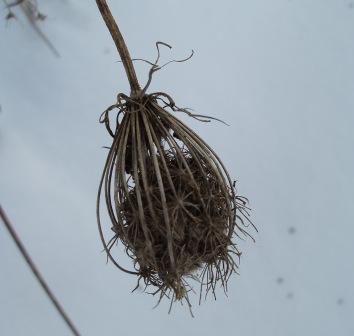by Carl Strang
Winter is a time when we slow down and become introspective. Sitting and staring into the fire, we ponder the big questions. If you have been following this blog, you know that the focus here is science, science that can be done simply in outdoor settings. But we are more than scientists, and science has well defined limitations that need to be understood by everyone who does science or studies its findings. This winter I am using one post per week to develop my own viewpoint and biases, in particular sharing my take on the relationship between science and spirituality. In part this defines for me what these two realms of human experience are all about, and also develops the separate methods used for inquiry in each realm. I plan to place this paragraph in front of each entry in this series, so that those who are interested only in natural history or in scientific practice can skip these posts.

The Eternal Tapestry
It may not be possible for our thoughts and visualizations to go beyond the limits imposed by our experience in space, time, and Umwelt. This is what we would need to do, however, if we were to view this world from God’s eternal perspective, encompassing every thing and all times at once. What would one of us look like from that perspective, which is consistent with relativity’s block-space-time? A worm, twisting through space-time, with one end at birth and the other at death? That’s just the part of ourselves projected into this world, though. And it’s a visual image, a physical-sensory one, defined and thereby limited by physical laws that are themselves limited by space and time. (Also, not a particularly pleasant comparison if you’re not a worm).
Nevertheless, this is where we must start, and it’s worthwhile, even if all that is accomplished is to point out the weakness of our grasp of ultimate reality. All of us space-time worms (and I include all things here, not just human beings) together might seem, from an Eternal (all-times-at-once) perspective, to be the threads of a tapestry. These threads (there, we’ve left that worm image behind; a more correct term from physics would be world-tubes) come together at “moments” when we are together with the threads of other people and things in particular places. Intuition and synchronicity imply that the tapestry is folded, bringing bits of the threads into proximity to one another at various “moments.”
Proximity to one’s own thread in the “future,” for instance, could represent a premonition. The first time I ran Section 4 of Wisconsin’s Wolf River in my kayak, the water level was fairly high, at 17 inches on the standard gauge. We came to the final drop, the intimidating Big Smoky Falls. One of the more experienced members of our group nearly flipped halfway down, but caught himself with a heroic brace. I had the opportunity to carry around the rapid, but I was inspired to reach out emotionally, and I got a feeling of myself having completed the run safely. No doubt it was beginner’s luck, but I hit the line perfectly, and went home with the exact feeling of relaxed contentment I had touched just before the run. Often, since then, I have been able to anticipate the positive outcome of various ventures, but can’t always make such contact with my future self (if that’s what is happening) when I try.
One reason I want to explore this Eternal perspective is to develop ideas on such things as our purpose in life, predestination, fate, etc. It’s easy to get the impression that, because those threads are complete from an Eternal perspective, all choice is taken away from us. But I don’t think that’s the case. Our experience of separateness and of time makes free will possible, expressed in the decisions we make in the moments of “time.” That allows us to be self-shaped entities while also being timeless and eternal. Thus the thread that represents me is self-weaving, creating its own route, its own shape in space-time. I experience the moments of decision, in my every day life, which create that shape. God-as-a-whole may not experience sequence, but we do. Incidentally, it seems to me that a person must be a different thing entirely when regarded from an eternal perspective. Our thoughts, images, experiences and emotions in each moment don’t cease to exist, but they must somehow all be there at once. Any concept of God-as-person needs to include this difficult perspective.
This image of a tapestry, composed of threads that represent the interwoven courses of our lives and unified to form a single body, resolves for me a question that I think has gotten inadequate attention. That is the tension between the mystical intuition of the oneness of all things, on the one hand, and the apparent division of the universe into the particularized 10,000 things (Rumi: “How can I be separated and yet in union?”). The tapestry reveals the connections between particularization and time, on the one hand, and between oneness and eternity, on the other. Each thread creates its shape as it winds through time, constrained by and interacting with the threads (simultaneously creating themselves) around it (note the parallel to the fractional dimensions of chaos theory). Collectively the threads are revealed as forming an eternal, singular tapestry of oneness.
I like the image of the tapestry, but I don’t want to be too attached to a single, limiting model. Another relevant idea that, however, requires us to bring time back in, is an analogy between the physicists’ momentary virtual particles popping in and out of the energy vacuum, on the one hand, and our emerging into the physical universe to be viewpoints of God and popping back out, on the other. I’m reminded of reported “near death” experiences of one’s entire life reviewed in a flash, which might be regarded as momentarily merging with eternity.

































